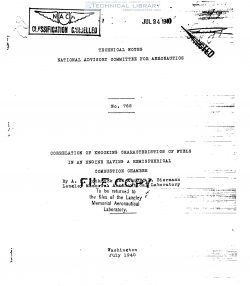naca-tn-768
- Version
- 145 Downloads
- 699.88 KB File Size
- 1 File Count
- November 30, 2016 Create Date
- November 30, 2016 Last Updated
National Advisory Committee for Aeronautics, Technical Notes - Correlation of Knocking Characteristics of Fuels in an Engine Having a Hemispherical Combustion Chamber

Data are presented to show the effects of inlet-air
pressure. inlet-air temperature, and compression ratio on
the maximum permissible performance obtained with a cylin—
der having a hemispherical-dome combustion chamber. The
five aircraft~engine fuels used have octane numbers vary-
ing from 90 to 100 plus 2 ml of tetraethyl lead per.gallonh
The data were obtained on a 5% -inch by éé-inch liduid— f
cooled engine operating at 2 ,500 rpm. The compression
ratio was varied from 6.0 to 8. 9. The inlet~air tempera-
ture was varied from 1109 to 310° F. For each set of con—
ditions, the inlet-air pressure was increased until audi— .
ble knock occurred and then reduced 2 inches of mercury-
before data were recorded. The results for each fuel can
be correlated by plotting the calculated end-gas density
factor against the calculated end—gas temperature. Meas~
urements of spark—plug electrode temperatures showed that,
with two spark plugs, cutting off the switch to one spark
plug lowered the electrode temperature of that plug from
a value of 1.3650 F to a value of 957° F. The results in-
dicate that the surface temperatures of combustion-chamber
areas which become new sources of ignition markedly in-
crease after ignition commences.
The N.A.C.A. has been conducting an investigation on
the knocking characteristics of high~octane fuels. Re~
suits obtained from an engine with a four—valve flat-disk
combustion chamber. from an engine with a four—valve pent—
roof combustion chamber, and from a G.F.R. engine have been
reported in references 1, 2, and 3, respectively.
Previous analyses of the problem of engine knock have
shown that the most important independent variables in any
one engine are the ones that control the end-gas density
and temperature and the mixture ratio. The results from
the previous tests showed that a certain amount of correla-
tion exists between the knocking—characteristic curves ob-
tained for several fuels used in different engines but that
certain differences are caused by the variation in engine
design.
| File | Action |
|---|---|
| naca-tn-768 Correlation of Knocking Characteristics of Fuels in an Engine Having a Hemispherical Combustion Chamber.pdf | Download |

Comment On This Post